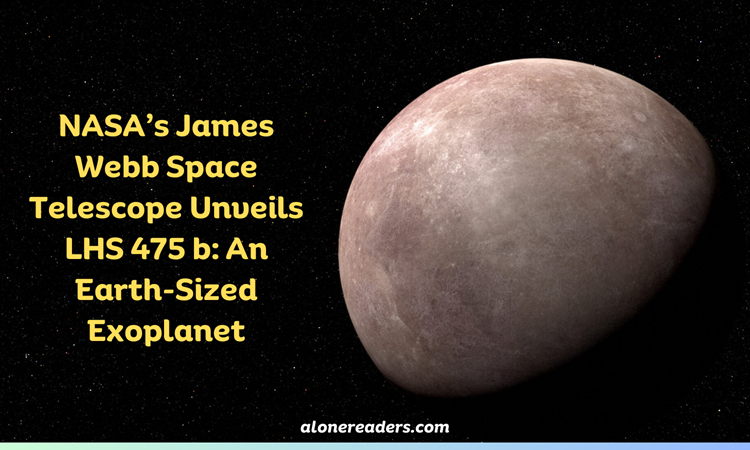
In the boundless tapestry of the cosmos, the James Webb Space Telescope (JWST) has been NASA's eye, piercing through the veil of interstellar space to unravel the universe's most profound secrets. Among its latest triumphs is the confirmation of an exoplanet named LHS 475 b, which astonishingly shares a near-identical size with our own Earth. This landmark discovery not only showcases the unparalleled capabilities of the JWST but also reignites the ever-persistent question: are we alone in the universe?
LHS 475 b was first detected by NASA's Transiting Exoplanet Survey Satellite (TESS), which identifies exoplanets by monitoring the dimming of stars as planets pass in front of them—a method known as the transit method. However, it was the JWST, with its unprecedented resolution and sensitivity, that confirmed the planet's existence and offered a more detailed look at its characteristics.
LHS 475 b orbits a red dwarf star approximately 41 light-years away from Earth, in the constellation Octans. Red dwarfs are among the most common types of stars in our galaxy, which makes the study of planets orbiting these stars particularly intriguing for astronomers. The proximity of LHS 475 b to its host star suggests a rapid orbit, with a year on this exoplanet lasting only a few Earth days.
What makes LHS 475 b especially significant is its size. With a diameter just 99% that of Earth's, it stands as one of the few known exoplanets to so closely match our planet in scale. This similarity has profound implications for the study of planetary formation, evolution, and the conditions that might support life.
The composition of LHS 475 b is a subject of ongoing research, with scientists eager to determine whether it has a rocky surface like Earth or is more akin to a mini-Neptune, with a thick atmosphere enveloping a possible ocean or solid core. JWST's suite of instruments, including the Near-Infrared Spectrograph (NIRSpec) and the Mid-Infrared Instrument (MIRI), are poised to analyze the planet's atmosphere by studying the starlight filtering through it during transits.
The question of LHS 475 b's habitability is complex. The planet's proximity to its star means it receives substantial radiation, which can be a double-edged sword. On one hand, if the planet has an atmosphere with greenhouse gases, it could potentially maintain liquid water on its surface. On the other hand, the intense radiation could strip away the atmosphere over time, leaving the surface barren and inhospitable.
Furthermore, the nature of red dwarf stars adds another layer to the puzzle. While they are long-lived and stable, red dwarfs are known for their frequent and powerful stellar flares, which could pose a significant threat to any potential life on orbiting planets.
One of the most exciting prospects of the JWST's study of LHS 475 b is the potential to search for biosignatures—indicators of life, such as the presence of oxygen, water vapor, or methane in the atmosphere. Detecting such molecules would not be conclusive evidence of life but would certainly place LHS 475 b high on the list of targets for future research and exploration.
The JWST, with its 6.5-meter primary mirror and location far beyond Earth's atmosphere, is uniquely equipped to study exoplanets in detail. Since its deployment, the telescope has been providing data of unprecedented quality, enabling astronomers to peer into the atmospheres of distant worlds, analyze their compositions, and understand their climates.
The confirmation of LHS 475 b's existence is a testament to the telescope's capabilities. It also represents a collaborative triumph, showcasing the synergy between different space telescopes, with TESS providing the initial detection and JWST offering the confirmatory and in-depth analysis.
Looking Ahead
As NASA's James Webb Space Telescope continues to gaze into the depths of space, its observations of LHS 475 b are expected to yield even more information. Each data point enriches our understanding of the galaxy's diverse planetary systems and brings us closer to answering the age-old question of whether Earth is unique in its ability to harbor life.
The discovery of LHS 475 b stands as a beacon of possibility—a celestial reminder that the search for worlds like our own is not just a matter of looking to the stars, but through them. With each passing day, the JWST is not only expanding our cosmic horizons but also bringing into sharper focus the potential for life beyond our solar confines.
The confirmation of LHS 475 b as an Earth-sized exoplanet by NASA's James Webb Space Telescope marks a pivotal moment in the field of astronomy and exoplanet research. As we continue to analyze the data from JWST and plan future missions, we edge ever closer to understanding our place in the universe. Whether LHS 475 b is a rocky haven teeming with life or a barren world sculpted by cosmic forces, its discovery is a powerful reminder of our enduring quest to find other worlds like our own.